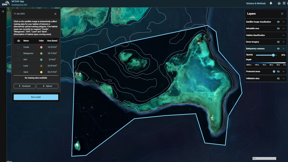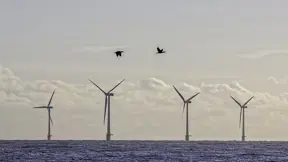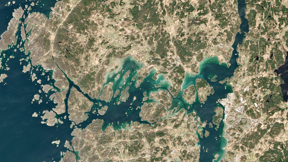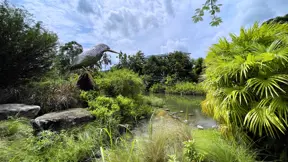
smartWhales: Applying integrated ecological modelling and operational systems to reduce risks to whales
Decision-support system forecasts whale movements and risk zones to enhance proactive regulatory decisions that protect North Atlantic Right Whales
With fewer than 350 individuals remaining, the North Atlantic Right Whale (NARW) is one of the world’s most endangered large whale species. These whales face threats from climate change-altered habitats, fishing gear entanglement and vessel strikes. To support conservation efforts, the Canadian Space Agency launched the smartWhales programme, funding research in two areas: Earth observation and ecological modelling. As part of this initiative, a team from WSP, DHI and their partners developed a decision-support system that forecasts where NARWs are likely to be based on habitat preferences and movement patterns. The system also includes forecasts of vessel movements and snow crab fisheries data in the Gulf of St. Lawrence, to simulate when and where whales may be at risk.
Challenge
The primary challenge addressed by the smartWhales programme was the lack of monitoring approaches and predictive tools capable of delivering sufficient spatiotemporal information on the location of NARWs and key stressors. This gap was seen as a hinderance to timely interventions, making it difficult to proactively mitigate vessel and fishing activities. Additionally, existing efforts were fragmented, with siloed data sources and modelling initiatives that limited effective decision-making. To tackle this, the team from DHI, WSP and their partners reframed the broader challenge into one that should apply existing data sources and innovative modelling technologies that improved the precision and effectiveness of existing vessel slow-down regulations and seasonal snow crab fishing restrictions. This included the goal to deliver an integrated decision support platform that provides regulatory agencies with proactive warnings of vessel–NARW collision risks, as well as early indications of periods when NARW movements overlap with snow crab fishing areas.
Solution
To support the protection of the endangered North Atlantic Right Whale (NARW), a pioneering ecological modelling driven web-based decision support system (DSS) was developed using MIKE Powered by DHI software.
Solution highlights:
- A well-calibrated hindcast hydrodynamic model was established as the foundation for the overall integrated modelling framework
- A habitat suitability model was developed through use of hydrodynamic model results, various environmental datasets, a machine learning model and DHI’s habitat modelling scripts
- Via coupling with the hydrodynamic and habitat suitability models, an agent-based model was developed to provide realistic simulations of NARW movement and presence
- Vessel collision risk forecast modelling was carried out with ecological models (i.e., after conversion from hindcast to forecast mode) and machine learning model vessel trajectory forecasts
- The forecast ecological models and data on snow crab fisheries areas were used to generate a forecast model of snow crab fishing gear entanglement risk
- A NARW decision-support system (DSS) for the Gulf of St. Lawrence was developed through backend scheduling of forecasted models and a GIS-based frontend
The DSS ultimately provides a 3-day forecast of hydrodynamic conditions, NARW habitat suitability and movements, fishing gear entanglement risk, as well as a 12-hour vessel trajectory and collision risk forecast.
Client:
Canadian Space Agency
Partner:
WSP Canada and others
Location:
Gulf of St Lawrence, Canada
Related SDG(s):
SDG 14: Conserve and sustainably use the oceans, seas and marine resources for sustainable development
Technology:
MIKE 21/3 Hydrodynamics
MIKE ABM Lab
MIKE OPERATIONS (Workflow Designer)
Open source machine learning models
Vessel trajectory ML model (Dalhousie University)
Results
The executed smartWhales research project successfully delivered an operational prototype of a NARW DSS, with various validation analyses confirming the quality of the modelling outputs. The promising results demonstrate that the DSS effectively provides advanced spatiotemporal forecasts, enabling regulators to make proactive decisions to reduce the risks of vessel strikes and fishing gear entanglements.
The project also provided proof of the technological readiness of the applied modelling and operational systems to forecast risks of target species. With continued investment, this promising technology could achieve full operational deployment and serve as a scalable framework for future conservation tools — supporting ongoing progress in marine protection efforts.
The project received significant recognition, including a 2024 Canadian Consulting Engineering ‘Award of Excellence’ and a special environmental stewardship award – Breton Environmental Award. It has also received a designation of ‘Highly Commended’ under the Digital Innovation category of the Environmental Analyst Sustainability Delivery Awards 2024.
About our client
The Canadian Space Agency is the national space agency of Canada, established in 1989 to lead and coordinate the country's space exploration, research, and technology development efforts. The agency plays a crucial role in developing space-based technologies that benefit Canadians and the global community, with projects spanning Earth observation, satellite communications, space robotics and exploration.
About our partner
WSP is one of the world’s leading professional services firms, uniting engineering, advisory and science-based expertise to shape communities to advance humanity. The company operates in over 50 countries and employs approximately 73,000 professionals, known as Visioneers. Together they pioneer solutions and deliver innovative projects across sectors: Transport & Infrastructure, Property & Buildings, Earth & Environment, Water, Power & Energy and Mining & Metals.
You may also like
How can we help?
With our global network of offices, we make sure you get the right answers to your local needs. Tell us about your water challenges and we will get back to you.




